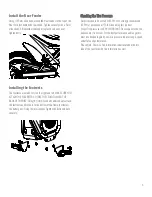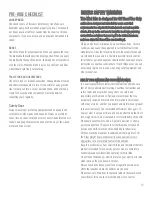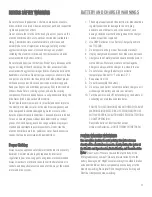
15
1.
Install the new chain by lacing the chain around the motor
sprocket. Maneuver the chain onto the sprockets on the
rear wheel and motor. Pull the chain tight. Place both
ends of the chain at 10 o’clock on the rear wheel
sprocket. This will make it easier to install the master
link. Slide the master link into the chain with the pins out,
place the outer side link onto the protruding master link
pin. Push the link together so that you can see the
retaining clip grooves in the pins. Lay the retaining clip
over the pins with the open end toward the back of the
bike and slide the clip in place using a pair of pliers. Make
sure the clip is locked in place.
2.
Roll the wheel while feeling the slack in the chain and find
the tightest spot in the chain. Using two 10mm wrenches.
Hold the adjusting bolt and loosen the Jam nut on the
chain adjuster bolts. Turn the chain adjuster bolts one flat
at a time counterclockwise to Tighten the chain adjusters.
Work both sides evenly to remove slack from the chain as
required. Keep rolling the wheel while checking the free
play in the chain. (fig A) When you have
½
” of Free play in
the chain at the tight spot tighten the axle nut. Recheck
chain free play by rolling the wheel around again to find
the tight spot and confirm that you still have the
½
” free
play. Hold the axle adjusting bolt with one 10mm wrench
and tighten the Jam Nut with the other 10mm wrench.
Recheck for free play and that the rear wheel rolls freely
3.
Now is a good time to lube the chain with chain lube.
Slowly roll the wheel while spraying chain lube on the
inside of the chain. Roll the wheel a few more times to
work the chain lube into the chain Do not spin the rear
wheel for 10-15 minutes after chain lube has been
applied.
1.
Reinstall the rear brake caliper. After the caliper has been
reinstalled, spin the rear wheel by hand and squeeze the
brake lever to make sure the wheel spins freely and the
brake works properly.
2.
Slide the chain guard back in place and reattach using
two 6mm allen screws. tighten using a 5mm allen wrench
3.
Test ride
Chain and Sprocket Notes:
The chain will typically have a “loose spot” and “tight spot”
corresponding with a sprocket rotational position. This is normal
and common to all chain-driven products due to run-out tolerances
of the sprockets. The chain should be adjusted to the ideal tension
with the chain in the tightest spot.
Proper chain alignment must be maintained. The wheel must not be
skewed. If the chain is noisy or rough running, check the
lubrication, tension and alignment of the sprockets, in that order.
WARNING: To avoid a pinch or injury keep fingers away from
moving sprockets and chain.




































